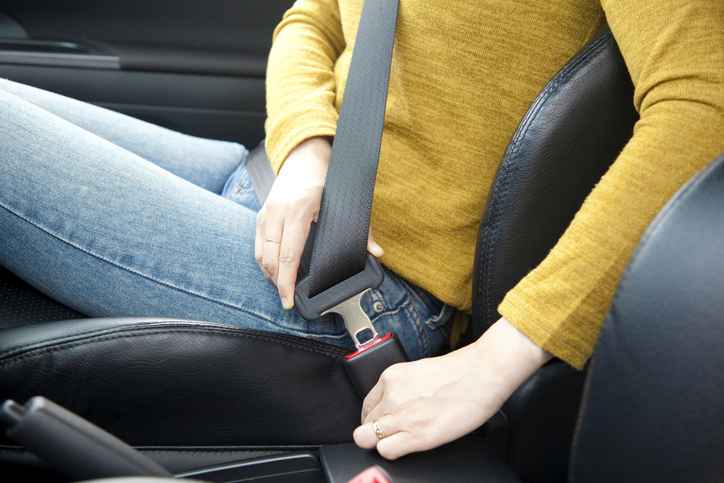It’s time to fasten your seat belt and stay out of the left lane for an extended period of time. If you live in Alabama, or at least plan to drive through the Heart of Dixie, you should be familiar with these new traffic laws.
New Alabama Seat Belt Law
If you’re an adult, get used to wearing a seat belt every time you ride in a vehicle in Alabama. A new seat belt law, passed by the Alabama legislature in early 2019 and effective September 1, requires each adult passenger to fasten their seat belt or face a possible fine.
In the past, only adults in the front seat and children riding in the back were required to buckle up. While some Alabama House Representatives believe the law will be difficult to enforce, most Legislators realize the important role seat belts play in saving lives and traffic safety.
The Alabama Department of Transportation reports that nearly 60 percent of those who died in vehicle crashes on Alabama roads in 2017 were not wearing a seat belt. According to the National Highway Traffic Safety Administration, seat belts saved almost 15,000 lives nationally in 2017. The data is pretty clear. Seat belts save lives.
The new law will be a secondary violation, which means officers will not stop vehicles for unbuckled adult riders in the back seat. However, if they spot an unbuckled violator during a primary violation stop, the officer can issue a citation.
Seat Belt Facts
Consider the potential consequences for not wearing your seat belt:
- The probability for severe injury rises dramatically if you are ejected from a vehicle. In fact, being completely ejected nearly always results in death. Buckling up keeps you secure in your seat.
- Air bags can cause serious injury and even death if you are not properly restrained. Remember, air bags are intended to work with seat belts, not replace them.
- Improper use of a seat belt, such as putting the strap under your arm, can increase your odds for injury when involved in a crash.
Guidelines for Seat Belt Safety
Follow these tips to stay safe when buckling up:
- Make sure the strap and lap belt fit securely against your chest and pelvis. These areas are more capable of sustaining crash forces than other body areas.
- Keep the shoulder strap in the middle of your chest, away from your neck.
- Never put the shoulder strap under your shoulder or behind your back.
- Purchase seat belt adjusters or extenders if needed to get a secure fit.
Seat Belt Safety Tips for Pregnant Women
Pregnancy is no excuse to avoid wearing a seat belt. In fact, doctors recommend using proper vehicle restraints through all stages of pregnancy.
For example, if you’re pregnant, make sure the lap belt is secured down low on your pelvic bone, never over or on top of your belly. Also, avoid reclining your seat too far back because it might create a gap between your shoulder and the strap.
The NHTSA developed an infographic to provide some helpful answers to common questions mothers-to-be often ask.
New Alabama Road Rage Law
The Alabama Anti-Road Rage Act became effective September 1, 2019 and requires drivers on the interstate to move out of the far left lane if they haven’t passed another vehicle for a mile-and-a-half.
The reason for the Anti-Road Rage Act is to keep traffic moving smoothly. When slower vehicles clog up the left lane, which is typically designated for passing, drivers who want to pass are often boxed in and forced to drive at a slower speed. This can often lead to frustration, anger and aggressive behavior.
Aggressive Drivers

If you get behind the wheel when you’re angry, or you allow other drivers to make you angry, you may have just made the road a more dangerous place. When you get angry, take a deep breath, calm down and stay in control.
However, not everyone practices safe driving habits. Many people drive angry.
So what can you do if you are confronted with an aggressive driver?
- Put your safety before your pride.
- Avoid eye contact, get out of the way of the driver as safely as you can, and ignore angry or aggressive gestures.
- Do not honk or draw attention to yourself.
- Avoid holding your position in traffic when you’re being followed too closely. It gives the control of the situation to the aggressive driver. Take control of your own safety first, and safely remove yourself from the situation.
Are You an Aggressive Driver?
Spotting aggressive behavior in others is a fairly easy task. Identifying your own aggressive behavior can be a bit more challenging.
Want to know where you stand on aggressive driving habits? Take the DriveSafe Online® “Are You an Aggressive Driver?” quiz to find out.
If you have received a ticket for not following these new traffic laws and are facing an increase in your auto insurance premiums due to a traffic violation, a DriveSafe Online® defensive driving course may help.

Patrick M. is Editorial Director for the always expanding DriveSafe Online library of courses. With over two decades of experience developing award-winning training, he now focuses on innovating online driver safety training. Pulling from his background in journalism, he steers the wheel behind the creation of top-tier content that promotes a better journey—whether on the digital highway of learning or the real roads we travel every day.
